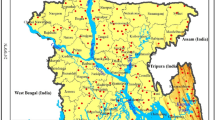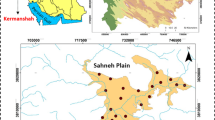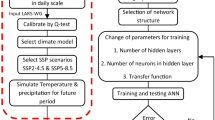Abstract
Chitravathi basin in India is facing significant challenges as its groundwater resources are facing the impact of land cover and climate change. This study explores the impact of land cover and climate change on groundwater levels and groundwater recharge in the basin using CMIP6 GCMs climate projections data. Taylor Skill Score (TSS) and Rating Metric (RM) were used to rank the GCMs. The top four ranked GCMs, i.e., MPI-ESM1-2-LR, EC-Earth3, MPI-ESM1-2-HR, and INM-CM5-0 were found to produce the most accurate projections under scenarios SSP2-4.5 and SSP5-8.5. Cellular Automata-Artificial Neural Network (CA-ANN) was used to develop future LULC maps. SWAT model was applied for estimating the future groundwater recharge and was calibrated and validated for discharge data, giving the values of R2 = 0.84 and 0.82 and NSE = 0.81 and 0.80 during calibration and validation, respectively. A steady-state groundwater flow model, MODFLOW, was employed to estimate future groundwater levels. Based on the projected groundwater recharge and levels, a resiliency map of the basin was developed. The results indicated that by 2060, under SSP2-4.5 scenario, groundwater levels in the basin would decrease by 54 m, while under the SSP5-8.5 scenario, the decrease would be 62 m. The groundwater resiliency for both SSPs would be poor in 2060. This research will help design and implement adaptation measures to mitigate the impacts of land cover and climate change on Chitravathi basin’s groundwater resources. These findings will help to protect and preserve the basin’s groundwater supplies.













Similar content being viewed by others
Data availability
Some or all data, models, or codes that support the findings of this study are available from the corresponding author upon reasonable request.
References
Abbaspour, K. C., Rouholahnejad, E., Vaghefi, S., Srinivasan, R., Yang, H., & Kløve, B. (2015). A continental-scale hydrology and water quality model for Europe: Calibration and uncertainty of a high-resolution large-scale SWAT model. Journal of Hydrology, 524, 733–752.
Adhikari, R. K., Mohanasundaram, S., & Shrestha, S. (2020). Impacts of land-use changes on the groundwater recharge in the Ho Chi Minh city, Vietnam. Environmental Research, 185, 109440.
Ahmed, K., Sachindra, D. A., Shahid, S., Iqbal, Z., Nawaz, N., & Khan, N. (2020). Multi-model ensemble predictions of precipitation and temperature using machine learning algorithms. Atmospheric Research, 236, 104806.
Alam, S., Gebremichael, M., Li, R., Dozier, J., & Lettenmaier, D. P. (2019). Climate change impacts on groundwater storage in the Central Valley, California. Climatic Change, 157(3-4), 387–406.
Alattar, M. H., Troy, T. J., Russo, T. A., & Boyce, S. E. (2020). Modeling the surface water and groundwater budgets of the US using MODFLOW-OWHM. Advances in Water Resources, 143, 103682.
Aneesha Satya, B., Shashi, M., & Deva, P. (2020). Future land use land cover scenario simulation using open-source GIS for the city of Warangal, Telangana, India. Applied Geomatics, 12, 281–290.
Chen, W., Jiang, Z., & Li, L. (2011). Probabilistic projections of climate change over China under the SRES A1B scenario using 28 AOGCMs. Journal of Climate, 24(17), 4741–4756.
Congalton, R. G., Oderwald, R. G., & Mead, R. A. (1983). Assessing Landsat classification accuracy using discrete multivariate analysis statistical techniques. Photogrammetric Engineering and Remote Sensing, 49(12), 1671–1678.
Dawid, W., & Bielecka, E. (2022). GIS-based land cover analysis and prediction based on open-source software and data. Quaestiones Geographicae, 41(3), 75–86.
Dey, A., Sahoo, D. P., Kumar, R., & Remesan, R. (2022). A multimodel ensemble machine learning approach for CMIP6 climate model projections in an Indian River basin. International Journal of Climatology, 42(16), 9215–9236.
Dosdogru, F., Kalin, L., Wang, R., & Yen, H. (2020). Potential impacts of land use/cover and climate changes on ecologically relevant flows. Journal of Hydrology, 584, 124654.
Ebrahimi, R. S., Eslamian, S., & Zareian, M. J. (2023). Groundwater level prediction based on GMS and SVR models under climate change conditions: Case study—Talesh Plain. Theoretical and Applied Climatology, 151(1-2), 433–447.
Erturk, A., Ekdal, A., Gurel, M., Karakaya, N., Guzel, C., & Gonenc, E. (2014). Evaluating the impact of climate change on groundwater resources in a small Mediterranean watershed. Science of the Total Environment, 499, 437–447.
Foody, G. M. (2020). Explaining the unsuitability of the kappa coefficient in the assessment and comparison of the accuracy of thematic maps obtained by image classification. Remote Sensing of Environment, 239, 111630.
Foster, S., & MacDonald, A. (2014). The ‘water security ‘dialogue: why it needs to be better informed about groundwater. Hydrogeology Journal, 22(7), 1489–1492.
Garg, V., Aggarwal, S. P., Gupta, P. K., Nikam, B. R., Thakur, P. K., Srivastav, S. K., & Senthil Kumar, A. (2017). Assessment of land use land cover change impact on hydrological regime of a basin. Environmental Earth Sciences, 76(18), 1–17.
Garner, G., Hannah, D. M., & Watts, G. (2017). Climate change and water in the UK: Recent scientific evidence for past and future change. Progress in Physical Geography, 41(2), 154–170.
Ghaith, M., & Li, Z. (2020). Propagation of parameter uncertainty in SWAT: A probabilistic forecasting method based on polynomial chaos expansion and machine learning. Journal of Hydrology, 586, 124854.
Harbaugh, A. W., Banta, E. R., Hill, M. C., & McDonald, M. G. (2000). Modflow-2000, the u. S. Geological survey modular ground-water model-user guide to modularization concepts and the ground-water flow process.
Hu, B., Teng, Y., Zhang, Y., & Chen, Z. (2019). The projected hydrologic cycle under the scenario of 936 ppm CO 2 in 2100. Hydrogeology Journal, 27(1), 31–53.
IPCC (Intergovernmental Panel on Climate Change). 2013. Climate change 2013: The physical science basis. Contribution of working group i to the fifth assessment report of the intergovernmental panel on climate change.
Isaacson, D. L., & Madsen, R. W. (1985). Markov chains- theory and applications (p. 270). ROBERT E. KRIEGER PUBLISHING COMPANY, INC..
Kamaraj, M., & Rangarajan, S. (2022). Predicting the future land use and land cover changes for Bhavani basin, Tamil Nadu, India, using QGIS MOLUSCE plugin. Environmental Science and Pollution Research, 29(57), 86337–86348.
Kaur, N., Kaur, S., Kaur, P., & Aggarwal, R. (2021). Impact of climate change on groundwater levels in Sirhind Canal Tract of Punjab, India. Groundwater for Sustainable Development, 15, 100670.
Kayet, N., Chakrabarty, A., Pathak, K., Sahoo, S., Mandal, S. P., Fatema, S., et al. (2019). Spatiotemporal LULC change impacts on groundwater table in Jhargram, West Bengal, India. Sustainable Water Resources Management, 5, 1189–1200.
Khalid, K., Ali, M. F., Abd Rahman, N. F., Mispan, M. R., Haron, S. H., Othman, Z., & Bachok, M. F. (2016). Sensitivity analysis in watershed model using SUFI-2 algorithm. Procedia Engineering, 162, 441–447.
Kumar, S., Narjary, B., Vivekanand, Islam, A., Yadav, R. K., & Kamra, S. K. (2022). Modeling climate change impact on groundwater and adaptation strategies for its sustainable management in the Karnal district of Northwest India. Climatic Change, 173(1-2), 3.
Malekinezhad, H., & Banadkooki, F. B. (2018). Modeling impacts of climate change and human activities on groundwater resources using MODFLOW. Journal of Water and Climate Change, 9(1), 156–177.
Mensah, J. K., Ofosu, E. A., Yidana, S. M., Akpoti, K., Kabo-bah, A. T. (2022). Integrated modeling of hydrological processes and groundwater recharge based on land use land cover, and climate changes: a systematic review. Environmental Advances, 8, 100224.
Mishra, V., Bhatia, U., & Tiwari, A. D. (2020). Bias-corrected climate projections for South Asia from coupled model intercomparison project-6. Scientific Data, 7(1), 338.
Moghaddasi, P., Kerachian, R., & Sharghi, S. (2022). A stakeholder-based framework for improving the resilience of groundwater resources in arid regions. Journal of Hydrology, 609, 127737.
Nash, J. E., & Sutcliffe, J. V. (1970). River flow forecasting through conceptual models’ part I—A discussion of principles. Journal of Hydrology, 10(3), 282–290.
NGWA (National Groundwater Association) (2016). NGWA consensus definitions of groundwater sustainability and resilience.
Noori, A. R., & Singh, S. K. (2021). Status of groundwater resource potential and its quality at Kabul, Afghanistan: A review. Environmental Earth Sciences, 80, 1–13.
Norouzi Khatiri, K., Niksokhan, M. H., Sarang, A., & Kamali, A. (2020). Coupled simulation-optimization model for the management of groundwater resources by considering uncertainty and conflict resolution. Water Resources Management, 34, 3585–3608.
Ostad-Ali-Askari, K., Ghorbanizadeh Kharazi, H., Shayannejad, M., & Zareian, M. J. (2019). Effect of management strategies on reducing negative impacts of climate change on water resources of the Isfahan-Borkhar aquifer using MODFLOW. River Research and Applications, 35(6), 611–631.
Ouhamdouch, S., Bahir, M., Ouazar, D., Carreira, P. M., & Zouari, K. (2019). Evaluation of climate change impact on groundwater from semi-arid environment (Essaouira Basin, Morocco) using integrated approaches. Environmental Earth Sciences, 78, 1–14.
Pandey, V. P., Dhaubanjar, S., Bharati, L., & Thapa, B. R. (2019). Hydrological response of Chamelia watershed in Mahakali Basin to climate change. Science of the Total Environment, 650, 365–383.
Pathak, A. A., & Dodamani, B. M. (2019). Trend analysis of groundwater levels and assessment of regional groundwater drought: Ghataprabha River Basin, India. Natural Resources Research, 28, 631–643.
Patil, N. S., Chetan, N. L., Nataraja, M., & Suthar, S. (2020). Climate change scenarios and its effect on groundwater level in the Hiranyakeshi watershed. Groundwater for Sustainable Development, 10, 100323.
Persaud, E., Levison, J., MacRitchie, S., Berg, S. J., Erler, A. R., Parker, B., & Sudicky, E. (2020). Integrated modelling to assess climate change impacts on groundwater and surface water in the Great Lakes Basin using diverse climate forcing. Journal of Hydrology, 584, 124682.
Roy, P., Pal, S. C., Chakrabortty, R., Chowdhuri, I., Saha, A., & Shit, M. (2022). Climate change and groundwater overdraft impacts on agricultural drought in India: Vulnerability assessment, food security measures and policy recommendation. Science of The Total Environment, 849, 157850.
Sadhwani, K., Eldho, T. I., & Karmakar, S. (2023). Investigating the influence of future landuse and climate change on hydrological regime of a humid tropical river basin. Environmental Earth Sciences, 82(9), 210.
Shrestha, S., Neupane, S., Mohanasundaram, S., & Pandey, V. P. (2020). Mapping groundwater resiliency under climate change scenarios: A case study of Kathmandu Valley, Nepal. Environmental Research, 183, 109149.
Sinha, R. K., & Eldho, T. I. (2018). Effects of historical and projected land use/cover change on runoff and sediment yield in the Netravati River basin, Western Ghats, India. Environmental Earth Sciences, 77, 1–19.
Sishodia, R. P., Shukla, S., Graham, W. D., Wani, S. P., & Garg, K. K. (2016). Bi-decadal groundwater level trends in a semi-arid south Indian region: Declines, causes and management. Journal of Hydrology: Regional Studies, 8, 43–58.
Sule, B. F., & Ayenigba, S. E. (2017). Application of GMS-MODFLOW to investigate groundwater development potential in River Meme catchment, Kogi State, Nigeria. International Journal of Sciences, 6(09), 39–51.
Taylor, K. E. (2001). Summarizing multiple aspects of model performance in a single diagram. Journal of Geophysical Research: Atmospheres, 106(D7), 7183–7192.
Taylor, R. G., Scanlon, B., Döll, P., Rodell, M., Van Beek, R., Wada, Y., et al. (2013). Ground water and climate change. Nature Climate Change, 3(4), 322–329.
Wang, B., Zheng, L., Liu, D. L., Ji, F., Clark, A., & Yu, Q. (2018). Using multi-model ensembles of CMIP5 global climate models to reproduce observed monthly rainfall and temperature with machine learning methods in Australia. International Journal of Climatology, 38(13), 4891–4902.
Wunsch, A., Liesch, T., & Broda, S. (2022). Deep learning shows declining groundwater levels in Germany until 2100 due to climate change. Nature Communications, 13(1), 1221.
Yen, H., White, M. J., Jeong, J., Arabi, M., & Arnold, J. G. (2015). Evaluation of alternative surface runoff accounting procedures using SWAT model. International Journal of Agricultural and Biological Engineering, 8(3), 64–68.
Yifru, B. A., Chung, I. M., Kim, M. G., & Chang, S. W. (2021). Assessing the effect of land/use land cover and climate change on water yield and groundwater recharge in East African Rift Valley using integrated model. Journal of Hydrology: Regional Studies, 37, 100926.
Yousefi, H., Zahedi, S., Niksokhan, M. H., & Momeni, M. (2019). Ten-year prediction of groundwater level in Karaj plain (Iran) using MODFLOW2005-NWT in MATLAB. Environmental Earth Sciences, 78, 1–14.
Zeydalinejad, N. (2022). Artificial neural networks vis-à-vis MODFLOW in the simulation of groundwater: A review. Modeling Earth Systems and Environment, 8(3), 2911–2932.
Zeydalinejad, N. (2023). An overview of the methods for evaluating the resilience of groundwater systems. Methods X, 10, 102134.
Zuo, D., Xu, Z., Yao, W., Jin, S., Xiao, P., & Ran, D. (2016). Assessing the effects of changes in land use and climate on runoff and sediment yields from a watershed in the Loess Plateau of China. Science of the Total Environment, 544, 238–250.
Author information
Authors and Affiliations
Contributions
Nathi Ajay Chandra conducted the research, analyzed the results, and drafted the manuscript. Sanat Nalini Sahoo corrected the manuscript and guided the study.
Corresponding author
Ethics declarations
Ethics approval
All authors have read, understood, and have complied as applicable with the statement on “Ethical responsibilities of Authors” as found in the Instructions for Authors.
Consent for publication
Yes
Competing interests
The authors declare no competing interests.
Additional information
Publisher’s note
Springer Nature remains neutral with regard to jurisdictional claims in published maps and institutional affiliations.
Rights and permissions
Springer Nature or its licensor (e.g. a society or other partner) holds exclusive rights to this article under a publishing agreement with the author(s) or other rightsholder(s); author self-archiving of the accepted manuscript version of this article is solely governed by the terms of such publishing agreement and applicable law.
About this article
Cite this article
Chandra, N.A., Sahoo, S.N. Groundwater levels and resiliency mapping under land cover and climate change scenarios: a case study of Chitravathi basin in Southern India. Environ Monit Assess 195, 1394 (2023). https://doi.org/10.1007/s10661-023-11995-z
Received:
Accepted:
Published:
DOI: https://doi.org/10.1007/s10661-023-11995-z




